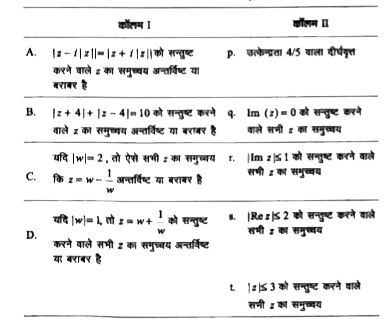माना और यदि सम्मिश्र संख्या z इस प्रकार है कि का कोणांक है, तो सिद्ध कीजिए कि .
The correct Answer is:
Step by step video, text & image solution for माना z_(1)=10+6i और z_(2)=4+6i यदि सम्मिश्र संख्या z इस प्रकार है कि ((z-z_(1)))/((z-z_(2))) का कोणांक (pi)/(4) है, तो सिद्ध कीजिए कि |z-7-9i|=3sqrt(2). by Maths experts to help you in doubts & scoring excellent marks in Class 12 exams.
Topper's Solved these Questions
- BOOK - JEE Main & Advanced (Hindi Medium)CHAPTER - सम्मिश्र संख्याएँEXERCISE - एकल पूर्णांक प्रश्न3videos
सम्मिश्र संख्याएँ
- BOOK - JEE Main & Advanced (Hindi Medium)CHAPTER - सम्मिश्र संख्याएँEXERCISE - मैट्रिक्स -सुमेल प्रकार2videos
सम्मिश्र संख्याएँ
- BOOK - JEE Main & Advanced (Hindi Medium)CHAPTER - समीकरण सिद्धान्तEXERCISE - एकल पूर्णांक प्रश्न1videos
समीकरण सिद्धान्त
- BOOK - JEE Main & Advanced (Hindi Medium)CHAPTER - सरल रेखा EXERCISE - एकल पूर्णांक प्रश्न1videos
सरल रेखा
Similar Questions
मान लीजिए कि z कोई सम्मिश्र संख्या (complex number) है जिसके लिए |z−3−2i|≤2 सत्य है, तो |2z−6+5i| का न्यूनतम मान है _______
08:41View Solutionकॉलम I में दिए गए वक्तव्यों का कॉलम II में दिए वक्तव्यों से सुमेल करें |
[नोट : z सम्मिश्र तल में मान लेता है एवं Im (z) तथा Re (z) क्रमशः z के काल्पनिक एवं वास्तविक भागों को दर्शाते है |]
 06:41View Solution
06:41View Solutionसमीकरण x4−4x3+12x2+x−1=0 के वास्तविक भिन्न मूलों (distinct real roots) कि संख्या है............
07:24View Solutionसमतल में स्थित किसी बिन्दु P से रेखाओ x - y = 0 तथा x + y = 0 की दुरी क्रमशः d1(P) तथा d2(P) है। यदि क्षेत्र R उन सभी बिन्दुओ P से बना है जो प्रथम चतुर्थांश (quadrant) में स्थित है तथा 2≤d1(P)+d2(P)≤4 को संतुष्ट करते है, तब क्षेत्र R का क्षेत्रफल है
01:54View SolutionIf z1,z2,z3,z4 are the roots of the equation z4+z3+z2+z+1=0, then the least value of [|z1+z2|]+1 is ( where [.] is GIF.)
02:45View SolutionLet z_(1)=10+6i and z_(2)=4+6i. If z is a complex number such that the argument of (z-z_(1))/(z-z_(2))is(pi)/(4), then prove that |z-7-9i|=3sqrt(2)
04:29View SolutionIf z1andz2 both satisfy z+¯z=2|z−1| and arg(z1−z2)=π4 , then find Im(z1+z2) .
02:17View SolutionIf z1,z2,z3,z4 are the affixes of four point in the Argand plane, z is the affix of a point such that |z−z1|=|z−z2|=|z−z3|=|z−z4| , then z1,z2,z3,z4 are
03:12View SolutionIf z_(1), lies in |z-3|<=4,z_(2) on |z-1|+|z+1|=3 and A=|z_(1)-z_(2)| then :
View SolutionIf z_(1) and z_(2) both satisfy the relation z+bar(z)=2|z-1| and arg(z_(1)-z_(2))=(pi)/(4) then Im(z_(1)+z_(2)) equals
07:26View SolutionIf z,z=z_(2) and |z_(1)+z_(2)|=|(1)/(z_(1))+(1)/(z_(2))| then
09:58View SolutionIf z_(1),z_(2),z_(3),z_(4) are the roots of equation z^(4)+z^(3)+z^(2)+z+1=0, then prod_(i=1)^(4)(z_(i)+2)
03:59View SolutionIf z1,z2,z3,z4 are complex numbers in an Argand plane satisfying z1+z3=z2+z4. A compex number 'z' lies on the line joining z1 and z4 such that Arg(z−z2z1−z2)=Arg(z3−z2z−z2). It is given that |z−z4|=5,|z−z2|=|z−z3|=6 then
01:17View Solutionयदि z1 व z2 दोनों प्रतिबन्ध z+¯z=2|z−1| और arg(z1−z2)=π4 को सत्यापित करते है तो ज्ञात Im(z1+z2) कीजिए।
05:54View Solutionयदि z1,z2 दो अशून्य सम्मिश्र संख्याएँ इस प्रकार हो कि |z1+z2|=|z1|+|z2|, तब, arg(z1)−arg(z2) बराबर है:
View Solution

